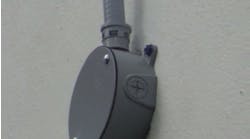Q. I don’t see where 300.4 limits the number of NM cables through a given opening in wood or metal framing members. I don’t want to turn the framing members into Swiss cheese and reduce their structural integrity by boring a hole for every NM cable. So how many NM cables can I install in each bored hole?
A.You’re correct, the NEC doesn’t limit the number of cables within an opening, and you must not reduce the structural strength of framing members below the requirements of the building code. However, where multiconductor NM cables are stacked or bundled longer than 24 inches, the allowable conductor ampacity, based on 90°C insulation rating of the conductors as listed in Table 310.16 [334.80], shall be adjusted in accordance with the multiplying factors contained in Table 310.15(B)(2)(a).
So what should you do? You can separate the cables after they pass through the framing members so that they aren’t bundled more than 24 inches. But you don’t have to worry about this if no more than nine current-carrying 14 AWG, 12 AWG, or 10 AWG conductors are bundled together for more than 24 inches.
New Ampacity of 14 AWG = 25A x 0.70 = 17.5A, OK with 15A protection
New Ampacity of 12 AWG = 30A x 0.70 = 21A, OK with 20A protection
New Ampacity of 10 AWG = 40A x 0.70 = 28A, OK with 30A protection [240.4(B)]
Got a Code question for Mike? Send it to him at [email protected].



